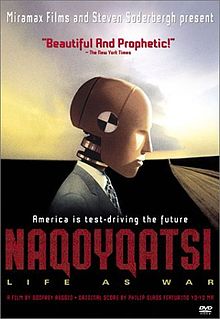- Naqoyqatsi
-
Naqoyqatsi 
Naqoyqatsi DVD coverDirected by Godfrey Reggio Produced by Joe Beirne
Godfrey Reggio
Lawrence TaubWritten by Godfrey Reggio Music by Philip Glass Cinematography Russell Lee Fine Editing by Jon Kane Distributed by Miramax Films Release date(s) October 18, 2002 Running time 89 minutes Naqoyqatsi (
 /nɑːkɔɪˈkɑːtsi/ nah-koy-kah-tsee),[1] also known as Naqoyqatsi: Life as War, is a 2002 documentary film directed by Godfrey Reggio and edited by Jon Kane, with music composed by Philip Glass. It is the third and final film in the Qatsi trilogy.
/nɑːkɔɪˈkɑːtsi/ nah-koy-kah-tsee),[1] also known as Naqoyqatsi: Life as War, is a 2002 documentary film directed by Godfrey Reggio and edited by Jon Kane, with music composed by Philip Glass. It is the third and final film in the Qatsi trilogy.Naqoyqatsi is a Hopi word (more correctly written naqö̀yqatsi) meaning "life as war". While Koyaanisqatsi and Powaqqatsi examine modern life in industrial countries and the conflict between encroaching industrialization and traditional ways of life, using slow motion and time-lapse footage of cities and natural landscapes, about eighty percent of Naqoyqatsi uses archive footage and stock images manipulated and processed digitally on non-linear editing (non-sequential) workstations and intercut with specially-produced computer generated imagery to demonstrate society's transition from a natural environment to a technology-based one. Reggio described the process as "virtual cinema".[2]
Contents
Synopsis
According to Reggio, the film has no screenplay per se, but three movements (like those of a symphony) with different themes:[2]:
- Numerica.com: Language and place gives way to numerical code and virtual reality.
- Circus maximus: Competition, winning, records, fame, “fair play” and the love of money are elevated to the prime values of life. Life becomes a game.
- Rocketship twentieth century: A world that language can no longer describe. The resulting explosive tempo of technology is war, civilized violence.
Production
The September 11 attacks against the World Trade Center took place very close to the film's production studio, impacting the content of the film and further convincing the crew of the importance of its subject.[2]
Music
The music is more in the traditional orchestral tradition than much of Glass's work as a familiar doorway to images so disconnected from the familiar world. One instrument, the cello played by Yo-Yo Ma, plays a single line running through the entire piece. Some unconventional instruments are used in addition to traditional ones, including a didgeridoo and an electronically-created jaw harp.[2]
Release
There was some controversy over the production process after the film was released on DVD. Since most of the archive and stock footage used in the film were shot in a 4:3 aspect ratio, most of the film was horizontally stretched to accommodate the wider aspect ratio used in the cinema and in the DVD transfer.
See also
References
- ^ "Naqoyqatsi Definitions". Koyaanisqatsi.org. Institute for Regional Education. http://qatsi.org/films/naqoyqatsi.php. Retrieved August 24, 2011.
- ^ a b c d Rotten Tomatoes website: Reviews and long article on Naqoyqatsi, with input and quotations from Godfrey Reggio and Philip Glass
External links
- The Trilogy's Home Page
- Official Miramax Films website for Naqoyqatsi
- Naqoyqatsi at the Internet Movie Database
- Naqoyqatsi at AllRovi
Qatsi trilogy Films Crew Presenters Categories:- 2002 films
- 2000s documentary films
- American films
- Avant-garde and experimental films
- Compositions by Philip Glass
- Films without speech
Wikimedia Foundation. 2010.
